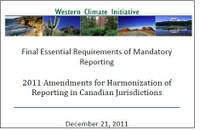Topic of the month April 2013: Carbon Footprinting of Investment Portfolios

Greenhouse Gas Emissions and their Impact on Investments
The world is closing in on Climate Change
As of this month, the 1,600 largest companies listed at the London Stock Exchange are for the first time obliged to report their greenhouse gas emissions to the public. Think this is a big thing? It is only a small piece in a huge paradigm shift happening as we speak.
Headline news: Countries force large greenhouse gas emitters to report their climate impact.
A few weeks ago, an even more revolutionary change in climate protection took place, something that almost went entirely unnoticed by the rest of the world. And yet it was an event that will have massive effects on lots of industries, companies and individuals, including investors. What happened? In early February 2013, the government of China, the world’s largest emitter of Greenhouse Gas Emissions, decided to put a 4 billion ton cap on its coal consumption and imports from 2015 onwards in order to get its emissions under control. Any excess usage will need to be paid for. China is putting a cost on its environmentally harming externalities.
This decision does not only put China on an unofficial track for the Kyoto protocol demands that the country still rejects- it is also in line with a global trend among countries and regions to put a price on carbon emissions. Be it through a carbon tax or cap-and-trade systems: More and more places around the globe make companies pay for their greenhouse gas emissions and it is by no means the developed world only, it is truly global. Aside from the European Emission Trading Scheme (EU ETS), also Australia, Ukraine, Morocco, South Africa, Zimbabwe, New Zealand, Indonesia, Kazakhstan, South Korea, Thailand, Vietnam, Colombia, Peru, Costa Rica, Chile, Brazil, several states in the US and Canada and a few Chinese provinces have already implemented or announced to put a price on carbon.
Why should there be a price on carbon? Because the damage is immense and so is the cost that will have to be paid by our children. Moreover, the countries that stand to suffer the worst damage from climate change today are also those that have contributed the least to its development. In the long term, the bill for this destruction will be presented to the large polluters and they will have to pay.
The invoice: An African magazine calling for paying the bill of climate damage (March 2013).
Companies embrace their climate impact
About 8% of all listed companies worldwide already acknowledge their responsibility for climate change. They create transparency around their greenhouse gas emissions by voluntarily disclosing them to their stakeholders. This works to their advantage, as such transparency is appreciated by clients and – more so – by investors and markets. The carbon-focused non-governmental organization CDP has shown that such companies have easier access to capital and outperform their peers in terms of returns.
Long-term investing: Carbon risk as investment risk.
However, for those companies not disclosing their climate impact voluntarily, legislation increasingly forces companies to report their greenhouse gas emissions. In 2011, France implemented mandatory carbon emission reporting for the country’s largest companies. The UK is also following suit and recently announced that the top 1,600 companies listed at the London Stock Exchange will have to report their greenhouse gas emissions from April 2013.
Judging by these recent global trends, it seems inevitable that the critique of companies responsible for climate change will spread even further.
Carbon Risk as Investment Risk
Why should investors care about carbon risk? Because the effects of climate change will hit their investments if they do not. Currently, you, as an investor, do not have to pay for carbon damage and instead benefit from the no-cost of the damaging gasses. But instead of pushing those costs to your children’s generation, the cost of carbon will increasingly have to be paid by companies that you might be invested in. This cost will hit your companies’ P&L, profits will shrink and the share price will tank. Carbon risk becomes investment risk. So as an investor, you should care for the greenhouse gas emissions of your investments and consider acting upon that knowledge. Divest from heavy emitters and replace them with less carbon-intense alternatives.
In the line of fire: Institutional investors are under pressure to declare the climate impact from their investments.
Institutional investors are already heavily looking into this issue. The world’s largest pension plans like Netherland’s PGGM and Norway’s state fund manager NIBM run their own climate change teams. An Institutional Investors Group on Climate Change is in operation since a while and large investment consultants like Mercer or KPMG have been publishing on the issue in the past. This is seconded by the United Nation’s initiative “Principles of Responsible Investments”, signed by over 1,000 institutional asset owners, asset managers and service providers.
Act now: Investors are taking steps to embrace climate change in their investment decisions.
Some investors have turned the table and identified good carbon management as an opportunity to generate smart and innovative investment ideas. For example South Africa based Nedbank uses the CDP disclosure ratings for companies to construct an investment product that has managed to significantly outperform the market over the past decade.
Triple bottom line investments: Better for the climate, for the business and for your returns (Source: CDP).
However, there are also other reasons to track your investment-related greenhouse gas emissions. Many investors increasingly see greenhouse gas management and its reporting as a proxy for good management. Being in control of your greenhouse gas emissions and bringing them down hints at a management that can shield itself to some extent against commodity price fluctuation as well as legislation requirements. Reporting such emissions reflects a management structure that values transparency, a virtue that many investors have as a criteria for investing. This can be seen by reports by the CDP that has shown that more transparent companies outperform less transparent ones over time.
Where to get reliable carbon data?
In sum, there are increasingly important reasons to monitor and act upon your investments’ greenhouse gas emissions. However, you need to first understand where to obtain reliable data from.
An obvious first step is to start on a company level. About 4,000 companies report their greenhouse gas emissions today, either through their company reporting – mainly Corporate Social Responsibility (CSR) reports – or through the NGO Carbon Disclosure Project. However, one of the main problems with such data results from the bias of self-reporting. Research has shown that as many as 25% of emission disclosing companies declare data points that are simply not trustworthy. None the less, most rating and ranking agencies focused on sustainability base their rating on just that data, resulting in a scenario where the data of one in four companies is incorrect.
In order to overcome this issue, it is best to turn to carbon specialists that understand the credibility of reported greenhouse gas information. South Pole Carbon has developed a “trust metric” that allows data users to understand how trustworthy a self-reported data point is. For emission information with a low credibility, the Zurich-based company provides an alternative data point that better captures the emission profile of the disclosing company.
The heat is on: Large asset owners feel the pressure to assess their investments’ climate impact.
Aside from disclosing poor-quality data, the even bigger challenge is all those 40,000+ investable companies NOT disclosing their greenhouse gas emissions. Here, it is necessary to intelligently approximate those companies’ greenhouse gas emissions. South Pole Carbon, together with researchers from ETH Zurich, has developed the most advanced methodology currently available in this sphere. Based on over 200 subsector models, the carbon footprint for any listed company can be established, with full transparency on the model quality.
By overcoming the challenge of poor data quality and reporting gaps, an unrestricted carbon footprinting of any public equity portfolio is now possible.
How can you screen your portfolio for greenhouse gas emissions?
How can asset managers and asset owners go about screening their investment portfolios for greenhouse gas emissions?
The easiest option is available since December 2012 when the innovative Bloomberg Carbon Screener application was launched. Simply log on to a Bloomberg Terminal and type APPS CARBON (GO). After running the application, a mask opens up that allows an easy upload of security tickers and weightings. With a mouse click, the tool produces a carbon footprint of your portfolio that can be imported into excel or as a factsheet for stakeholder reporting.
Assessments at your fingertip: Investment carbon footprint on Bloomberg (Source: Bloomberg).
Alternatively, investors can employ service providers for individualized and bespoke portfolio greenhouse gas assessments. This is more expensive but allows for a more tailor-made solution. Aside from public equity screenings, new services such as ESG Analytics allow for the first time also carbon screenings of private equity investments.
Finally, there are more revolutions to come. Keep your eyes open for such an unique service on YourSRI: An automatic Investment Carbon Screening tool will be available this summer!
 | Author: Dr. Maximilian Horster, Managing Partner of South Pole Climate Neutral Investments m.horster@southpolecarbon.com |
-----------------------
Free Trial & Further Information
yourSRI does offer a free trial access to its database, no obligations and no fine print - please register here and join now.
In order to show the advantages and offerings of one of the leading databases in responsible investing worldwide, yourSRI is hosting a series of webinars. Click here to register
If you are interested in further information, please contact us.
















